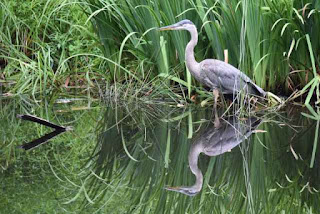Blue Carbon Sequestration at risk not only in Pakistan but globally
Carbon sequestered by way of aquatic plant, coastal sediments and coastal ecosystems such as mangrove forests, sea grass meadows or inter tidal salt marshes is called blue carbon. These blue sequester components protect people from coastal erosion, storms and flooding; also making them valuable for climate change adaptation and provide nursery grounds for fish.
Blue carbon sequestration is very important to control global warming, it absorbs carbon 40 times faster than terrestrial forests. terrestrial forests and plant biomass such as leaves, stems, branches or roots are pretty good at carbon sequestration, but their carbon stores are bound to the lifetime of the trees, for only 100 or so years, and then it is released back into the atmosphere,especially when it is cut down before maturity , blue carbon can be sequestered for years to decades, and for thousands to millions of years in underlying plant sediments
.
Blue carbon sink components include mangroves, salt marshes and sea grasses, are found on every continent except Antarctica, cover less than 0.5% of the seabed. they are responsible for more than 50%, and potentially up to 70%, of all carbon storage in ocean sediments. These coastal ecosystems cover between 13.8 and 15.2 million hectares (Mha), 2.2 and 40 Mha, and 17.7 and 60 Mha, respectively. Combined, these ecosystems cover approximately 49 Mha.
One of the main concerns with Blue Carbon is the rate of loss of these important marine ecosystems is much higher than any other ecosystem on the planet, even compared to rainforests. Current estimates suggest a loss of 2-7% per year, which is not only lost carbon sequestration, but also lost habitat that is important for managing climate, coastal protection, and health.
A mangrove is a shrub or small tree that grows in coastal saline or brackish water. The term is also used for tropical coastal vegetation consisting of such species. Mangroves occur worldwide in the tropics and subtropics. Mangroves are being lost at a rate of 2% per year. Experts estimate that carbon emissions from mangrove deforestation account for up to 10% of emissions from deforestation globally, despite covering just 0.7% of land coverage.
In Pakistan, mangrove swamps of the Sindh coastal zone are extensive, covering 243,000 hectares (ha) compared with 7,400 ha along the Balochistan coast.
A marsh is a wetland that is dominated by herbaceous rather than woody plant species. Marshes can often be found at the edges of lakes and streams, where they form a transition between the aquatic and terrestrial ecosystems. The three main types of marsh are salt marshes, freshwater tidal marshes, and freshwater marshes. carbon sequester rate in all three types is different.
Marshes have high productivity, with a large portion of primary production in below ground biomass. Marshes sequester carbon in underground biomass due to high rates of organic sedimentation and anaerobic-dominated decomposition. Salt marshes cover approximately 22,000 to 400,000 km2 globally, with an estimated carbon burial rate of 210 g C m−2 yr−1.
Tidal marshes are being lost at a rate of 1-2% per year. They cover roughly 140 million hectares of Earth’s surface. They have lost more than 50% of their historical global coverage. Pakistan is blessed to have more than 240 major wetlands including 19 Ramsar sites, which are international significant wetlands, covering an area of 1,343,627 hectares (3,320,170 acres) in Pakistan.
Seagrasses are a group of about 60 angiosperm species that have adapted to an aquatic life (here sponges, clams, small fish and other filter feeders thrive), and can grow in meadows along the shores of all continents except Antarctica. they are essential for coral reef formations. seagrass meadows form in maximum depths of up to 50m, depending on water quality and light availability, and can include up to 12 different species in one meadow.
Seagrasses are in global decline, with some 30,000 km2 (12,000 sq mi) lost during recent decades. seagrasses are about 177,000 sq km left globally. ‘Seagrass meadows are negatively affected by impacts accruing from the billion or more people who live within 50 km of them.
Carbon sequestration rates in seagrass meadows vary depending on the species, characteristics of the sediment, and depth of the habitats, but on average the carbon burial rate is approximately 138 g C m−2 yr−1.
Keeping in mind the current scenario of such rapidly decreasing rate of blue carbon sinks, practical steps must be taken not only for survival of remaining aquatic plants but also for plantation of new plants and to safe their habitat because all thees are complexity inter connected and important for climatic control.







Comments
Post a Comment